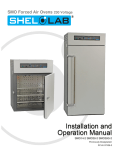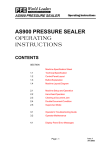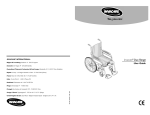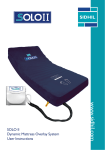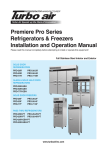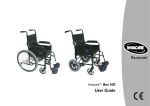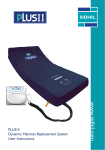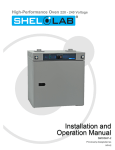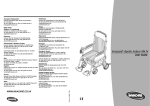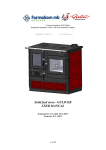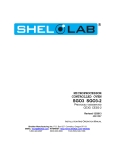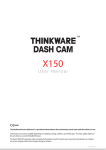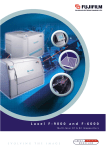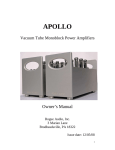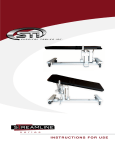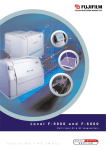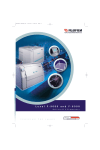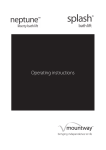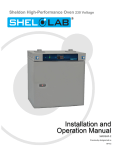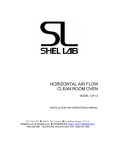Download User Manual SMO14-2 SMO28-2 - Cambridge Environmental
Transcript
Forced Air Ovens 230 Voltage Installation and Operation Manual SMO14-2, SMO28-2 Previously designated as FX14-2, FX28-2 SMO Forced Air Ovens 230 Voltage Previously designated FX Forced Air Ovens Installation and Operation Manual Part number (manual): 4861581 Revision: April 29, 2014 These units are TÜV CUE listed as forced air ovens for professional, industrial, or educational use where the preparation or testing of materials is done at approximately atmospheric pressure and no flammable, volatile, or combustible materials are being heated. These units have been tested to the following requirements: CAN/CSA C22.2 No. 61010-1:2012 CAN/CSA C22.2 No. 61010-2-010 + R:2009 UL 61010A-2-010:2002 UL 61010-1:2012 EN 61010-1:2010 EN 61010-2-010:2003 IEC 61010-1:2010 IEC 61010-2-010:2003 2|Page TABLE OF CONTENTS INTRODUCTION........................................................................................................................................... 4 General Safety Considerations ................................................................................................................. 4 Engineering Improvements ....................................................................................................................... 4 Contacting Assistance ............................................................................................................................... 5 RECEIVING YOUR OVEN ............................................................................................................................ 6 Inspecting the Shipment ............................................................................................................................ 6 Returning the Shipment ............................................................................................................................ 6 Recording Data Plate Information ............................................................................................................. 6 GRAPHIC SYMBOLS ................................................................................................................................... 7 CONTROL PANEL OVERVIEW ................................................................................................................... 9 INSTALLATION .......................................................................................................................................... 11 Power Source .......................................................................................................................................... 12 Location ................................................................................................................................................... 11 Lifting and Handling ................................................................................................................................ 11 Leveling ................................................................................................................................................... 11 Shelving Installation ................................................................................................................................ 13 Cleaning .................................................................................................................................................. 14 Burn In ..................................................................................................................................................... 14 OPERATION ............................................................................................................................................... 15 Operating Precautions ............................................................................................................................ 15 Setting up the Oven ................................................................................................................................ 15 Burn In: First Use .................................................................................................................................... 16 Setting the Temperature Controller Set Point ......................................................................................... 16 Calibrating the Unit .................................................................................................................................. 17 Setting the Over Temperature Limit Control ........................................................................................... 18 Setting the Timer ..................................................................................................................................... 19 Activating the Heating Cycle ................................................................................................................... 20 USER MAINTENANCE ............................................................................................................................... 21 Cleaning .................................................................................................................................................. 21 Disinfecting .............................................................................................................................................. 21 Unit SPECIFICATIONS .............................................................................................................................. 23 Weight ..................................................................................................................................................... 23 Dimensions .............................................................................................................................................. 23 Capacity .................................................................................................................................................. 23 Shelf Capacity by Weight ........................................................................................................................ 24 Temperature ............................................................................................................................................ 24 Power ...................................................................................................................................................... 24 PARTS LIST ............................................................................................................................................... 25 Parts ........................................................................................................................................................ 25 3|Page INTRODUCTION Thank you for purchasing a Sheldon Manufacturing SMO Forced Air Oven. We know that in today’s competitive marketplace, customers have many choices when it comes to constant temperature equipment. We appreciate you choosing ours. Our continued reputation as a leading laboratory product manufacturer rests with your satisfaction. Sheldon Manufacturing, Inc. stands behind our products, and we will be here if you need us. These ovens are intended for professional, industrial, and educational applications. The ovens are not intended for use at hazardous or household locations. Before you use the oven read this entire manual carefully to understand how to install, operate, and maintain the oven in a safe manner. Keep this manual available for use by all oven operators. Ensure that all operators are given appropriate training before the oven begins service. Note: Failure to follow the guidelines and instructions in this manual may create a protection impairment by disabling or interfering with the unit’s safety features. This can result in injury or death. GENERAL SAFETY CONSIDERATIONS Your oven and its recommended accessories have been designed and tested to meet strict safety requirements. For continued safe operation of your oven, always follow basic safety precautions including: Follow any local or regional ordinances in your area regarding the use of this unit. Only use the oven for its intended range of applications. Use only approved accessories. Do not modify system components. Any alterations or modifications to your oven may be dangerous and will void your warranty. Always hardwire the unit’s power feed to an earth grounded electrical source that conforms to national and local electrical codes. If the unit is not grounded, parts such as, knobs and controls may conduct electricity and cause serious injury. Avoid damaging the power feed. Do not bend it excessively, step on it, place heavy objects on it. A damaged power feed can easily become a shock or fire hazard. Never use a power feed after it has been damaged. Do not position the equipment in such a manner as to make it difficult to disconnect or uncouple the power feed. Do not attempt to move the unit while in operation or before the unit has cooled. ENGINEERING IMPROVEMENTS Sheldon Manufacturing continually improves all of its products. As a result, engineering changes and improvements are made from time to time. Therefore, some changes, modifications, and improvements may not be covered in this manual. If your unit’s operating characteristics or appearance differs from those described in this manual, please contact your Shel Lab dealer or customer service representative for assistance. 4|Page INTRODUCTION (CONTINUED) CONTACTING ASSISTANCE If you are unable to resolve a technical issue with your oven, please contact Sheldon Technical Support. Phone hours for Sheldon Technical Support are 6am – 4:30pm Pacific Coast Time (west coast of the United States, UTC -8). Please have the following information ready when calling or emailing Technical Support: the model number and the serial number (see page 6). EMAIL: [email protected] PHONE: 1-800-322-4897 extension 2, or (503) 640-3000 FAX: (503) 640-1366 Sheldon Manufacturing INC. P.O. Box 627 Cornelius, OR 97113 5|Page RECEIVING YOUR OVEN Before leaving our factory, all SMO ovens are packaged in high-quality shipping materials to provide protection from transportation-related damage. When an oven leaves our factory, safe delivery becomes the responsibility of the carrier. Damage sustained during transit is not covered by the oven’s warranty. When you receive your SMO oven, inspect it for concealed loss or damage to its interior and exterior. If you find any damage to the oven, then follow the carrier’s procedure for claiming damage or loss. INSPECTING THE SHIPMENT Carefully inspect the shipping carton for damage. Report any damage to the carrier service that delivered the SMO oven. If the carton is not damaged, open the carton and remove the contents. The unit should come with an Installation and Operation Manual, warranty card, and a Certificate of Compliance. Verify that the correct number of shelves, shelf slides, and leveling feet have been included (see the following table for quantities). Included accessories Model Shelves Shelf Clips Leveling Feet SMO14-2 (FX14-2) 3 12 4 SMO28-2 (FX28-2) 6 24 4 Carefully check all packaging before discarding. Save the shipping carton until you are certain that the unit and its accessories function properly. RETURNING THE SHIPMENT If you must return the oven for any reason, first contact your service representative for a return of material authorization (RMA). You must provide the unit’s data plate information. See Recording Data Plate Information below. RECORDING DATA PLATE INFORMATION Locate the data plate on the back of the oven next to the power inlet. The data plate contains the oven model number and serial number. Enter this information below for future reference. Date Plate Information Model Number Serial Number 6|Page GRAPHIC SYMBOLS The oven is provided with multiple graphic symbols on the control panel and adjacent to the power inlet. The symbols identify hazards and the functions of the adjustable components, as well as important notes in the user manual. Symbol Definition Indicates that you should consult your service manual for further instructions. Indique que l'opérateur doit consulter le manuel d'utilisation pour y trouver les instructions complémentaires. Indicates Temperature Repère température Indicates the Over Temperature Limit system Indique le système de dépassement de temperature Indicates AC Power Repère le courant alternative Indicates I/ON and O/OFF I repère de la position MARCHE de l'interrupteur d'alimentation O repère de la position ARRÊT de l'interrupteur d'alimentation Indicates protective earth ground Repère terre électrique Indicates UP and DOWN respectively Touches de déplacements respectifs vers le HAUT et le BA Indicates a Manually Adjustable control Indique un bouton réglable manuellement Indicates a Potential Shock Hazard Signale danger électrique WEEE Directive compliant logo Indicates the unit should be recycled (Not disposed of in land-fill) Indique l’appareil doit être recyclé (Ne pas jeter dans une décharge) 7|Page GRAPHIC SYMBOLS (CONTINUED) Symbol Definition Indicates the timer Indique le minuterie Start or Stop the Timer Lancer ou arrêter le minuteur Reset the Timer Réinitialisation de la Minuterie Indicates: Caution hot surface Indique: Avertissement symbole de surface chaude 8|Page CONTROL PANEL OVERVIEW Figure 1: Control Panel SMO14-2 and SMO28-2 Power Switch The main power switch on the control panel (green lighted I/O) controls all power to the unit and must be in the I (ON) position before any systems are operational. The switch will be lighted when in the I (ON) position. Timer Switch The black I/O switch marked TIMER is located to the right of the power switch. It controls the power to the timer circuit. In the OFF position oven heating has no timed duration. In the ON position heating runs for a user-programed timed interval and then shuts off. Over Temperature Limit Thermostat (OTL) This control is marked SET OVER TEMPERATURE and is equipped with a graduated dial. It is independent of the Main Controller and guards against any equipment failure which would allow the temperature to rise past the Main Controller’s set point. This allows continued operation of the oven in the event of a Main Controller failure, until the problem can be corrected or service can be arranged. Operating the incubator for extended periods of time using only the Over Temperature Limit feature is not recommended, as the chamber’s temperature stability and uniformity will suffer. OTL Light The red pilot light marked OVER TEMPERATURE ACTIVATED will illuminate when the Over Temperature Limit Thermostat has taken control of the oven. Under normal operating conditions this pilot lamp should never turn on. Timer Control Pad Marked SET TIMER, this control and display consist of the RESET button, UP / DOWN arrow buttons, a START/STOP button, a green digital display, and a TIMER ACTIVATED indicator LED. These controls and display are used to set up a timed heating cycle, activate the start of a timed heating cycle, and to end an active timed heating cycle. 9|Page CONTROL PANEL (OVERVIEW) Main Temperature Control Marked SET TEMPERATURE, this control consists of a green LED numerical display and an UP / DOWN arrow pad used for inputting set point temperatures and calibration offsets. Heating Activated Light The green pilot light labeled HEATING ACTIVATED illuminates whenever the oven heating elements are receiving power. 10 | P a g e INSTALLATION Installation of the unit requires permanent connect wiring (commonly known as hardwiring) and should be performed by a qualified electrical technician. All other steps can be performed by the end user. This oven is intended for use indoors, at room temperatures between 15C and 30C (59F and 86F), at no greater than 80% Relative Humidity (at 25C / 77F). Allow a minimum of 12 inches (30cm) between the oven and any walls or partitions, as well as 12 inches (30cm) of vertical headspace clearance above the top of the oven for unobstructed airflow and cooling. Operating the unit outside of these conditions may adversely affect the temperature range and stability. For conditions outside of those listed above, please contact your distributor or Sheldon Sales to explore other oven options suited to your laboratory or production environment. LOCATION When selecting a location to install the oven, consider all environmental conditions that can affect unit’s effective temperature range, uniformity, and stability. For example: Other ovens, autoclaves, and any device that produces significant radiant heat Heating and cooling ducts, or other sources of fast moving air currents High-traffic areas Direct sunlight LIFTING AND HANDLING The oven is heavy. Use appropriate lifting devices that are sufficiently rated for these loads. Follow these guidelines when lifting the oven: Lift the oven only from its bottom surface. Doors, handles, and knobs are not adequate for lifting or stabilization. Restrain the oven completely while lifting or transporting so it cannot tip. Remove all moving parts, such as shelves and trays, and lock doors in the closed position during transfers to prevent shifting and damage. LEVELING Make sure that the oven is level and stable. Each SMO oven ships with four leveling feet. Insert one leveling foot into each of the four holes in the bottom corners of the oven. Stand the oven upright. Then, adjust the foot at each corner until the oven stands level and solid without rocking. To raise a foot, turn it in a counterclockwise direction; to lower a foot, turn it in a clockwise direction. Note: To prevent damage when moving the oven, turn each of the four leveling feet completely clockwise. 11 | P a g e INSTALLATION (CONTINUED) POWER SOURCE These ovens are intended for a 230 volt, 50/60 Hz application at the following amperages: 12 Amp SMO14-2; 20 Amp SMO28-2. Check the oven’s data plate to verify voltage and ampere requirements before connecting to a power source. The oven’s power feed must be wired into an earth grounded source. Position the oven so the enduser has access to the power feed disconnect. The power source for the oven must conform to all national and local electrical codes Supplied voltage must not vary more than 10% from the data plate rating. Damage to the oven may result if supplied voltage varies more than 10%. Before energizing the oven it must be grounded using the protective conductor terminal (green with yellow stripe wire. Do not remove the protective conductor (earth connection). Removing the protective conductor will negate the oven’s protections against potentially dangerous electric shocks and create a possible fire hazard. A separate circuit is recommended to prevent possible loss of product due to overloading or failure of other equipment on the same circuit. A switch or circuit-breaker must be used in the building installation. The required circuit-breakers are: SMO14-2 15A and SMO28-2 30A (FX14-2 15A and FX28-2, 30A). The wires for power source connection should be in accordance with the following: SMO14-2 (FX14-2).: Green/Yellow – Earth; Red – Hot; Black – Hot. SMO28-2 (FX28-2): Green/Yellow – Earth; Black – Hot; Black – Hot. The Disconnect must be in close proximity to the equipment and within easy reach of the operator. The Disconnect must be marked as the disconnecting device for the equipment. 12 | P a g e INSTALLATION (CONTINUED) SHELVING INSTALLATION SMO Oven Shelf Installation Perform the following steps to install the SMO shelves: 1. Install the shelf clips in the slots located on the sides of the chamber interior, front and back. 2. Squeeze each clip, insert the top tab first, and then the bottom tab using a rocking motion. 3. Hang the metal shelves from the clips. Figure 4: Shelving Clips SMO14-2 and SMO28-2 Rear Panel 13 | P a g e INSTALLATION (CONTINUED) CLEANING The oven interior was cleaned at the factory but not sterilized. See the Cleaning topic in the User Maintenance section for more information. BURN IN The oven should be run through a burning in process before being used for normal operations. This is done to eliminate smoking from the protective coatings on the oven’s heating elements. Please see the Burn In procedure in the Operation Section. 14 | P a g e OPERATION OPERATING PRECAUTIONS Warning: The SMO oven is not an explosion proof unit! The oven is not designed to safely contain combustible gasses. Do not place explosive, combustible, or flammable materials into the chamber. 1. The bottom surface of the chamber should not be used as a work surface 2. Do not operate the oven in an environment with noxious fumes. 3. The SMO oven is provided with dampered intake and exhaust vents. For safe and efficient oven operation follow these precautions: a. In normal heating the vents are closed. b. Outgassed byproducts maybe hazardous to or noxious for operating personal. If either is the case, oven exhaust should be positively ventilated to a location outside workspace in accordance with national and local regulations. 4. Do not place sealed or filled containers in the oven. 5. Do not place mercury thermometers in the oven. 6. The SMO oven is not designed for use in Class I, II, or III locations as defined by the US National Electric Code. Warning: The vent dampers may be hot to the touch. These areas are marked with Hot Surface labels. Proper PPE should be employed to minimize risk to burn. Avertissement:Les clapets d'aération peuvent être chauds au toucher. Ces zones sont marqués avec des étiquettes de Surface chaude. Les EPI approprié devraient être employée pour réduire au minimum le risque de brûler. SETTING UP THE OVEN 1. Push the Power switch to the ON position. The Temperature Display will illuminate. 2. Using a coin or flathead screwdriver, turn the Over Temperature Limit control knob all the way clockwise. This is to ensure that the Over Temperature Limit feature will not interfere with the burn in procedure, setting up a starting temperature set point, and the temperature calibration process. 3. Set up the oven for use by following these procedures after the oven has been installed in the location where it will be used. All procedures are located in the Operation Section: Burn In: First Use page 16 Setting the Temperature Controller Set Point page 16 Calibrating the Unit page 17 Setting the Over Temperature Limit Control page 20 15 | P a g e OPERATION (CONTINUED) BURN IN: FIRST USE The steps below will help to eliminate smoking from the heating elements’ protective coatings. 1. If you have not already done so, turn the Over Temperature Control knob all the way clockwise to its maximum setting. 2. Open the unit’s exhaust vents. It is recommended that the oven’s exhaust be positively vented outside of the oven’s workspace during the Burn In. 3. Set the oven’s Temperature Controller to 200°C by doing the following. 4. Press either the Up or Down arrow pad button on the Set Temperature control once. 5. This display will start to blink and go dim, displaying an adjustable set point temperature value in Celsius. 6. Adjust the temperature set point by using the Up and Down arrow buttons. Enter 200. 7. The display will cease blinking and show the current chamber temperature. 8. A temperature set point of 200°C is now entered in the oven, and the oven will begin heating toward 200°C 9. Run the oven for a minimum of one (1) hour until smoke from the heating elements dissipates. SETTING THE TEMPERATURE CONTROLLER SET POINT This procedure adjusts oven’s the temperature set point, and may be used as often as needed. 1. Press either the Up or Down arrow pad button on the Set Temperature control once. 2. This display will start to blink and go dim, displaying an adjustable set point temperature value in Celsius. 3. Adjust the temperature set point by using the Up and Down arrow buttons. 4. Enter the temperature you will be running the oven at. 5. Once the desired temperature is selected, wait 5 seconds. 6. The display will cease blinking and show the current chamber temperature. 7. Your temperature set point is now entered in the oven, and the oven will begin heating toward the set point. 16 | P a g e OPERATION (CONTINUED) Note: Allow the oven to heat to up the set point, and then stabilize there with no change in the temperature reading for at least a half hour (30 minutes) prior to performing a Temperature Calibration. This is to ensure the best possible temperature uniformity in the oven chamber. Note: The open / close position of the dampered vents will affect the temperature performance of the oven when performing a calibration. It is important to allow the oven to stabilize at its set point temperature for a half hour with the vents set in position they will be in during normal use. Failure to do so may result in inaccurate temperature readings. CALIBRATING THE UNIT 1. After the unit has stabilized at its set point temperature, place the temperature sensor of a certified remote reading device inside the oven, as close as possible to the oven chamber’s geometric center. Secure in place against movement. Note: Always use an independently certified temperature sensing device that is regularly calibrated to 0.1°C by a third party to conduct temperature calibrations or verifications. 2. Allow the temperature to re-stabilize after closing the door. The remote reading device’s temperature measurement should not change for at least 15 minutes. 3. Read the temperature sensor’s display. Compare its reading with the temperature shown in the incubator’s Temperature Display. 4. If the independent temperature device’s and the unit’s temperature readings are the same or fall within the range of your laboratory protocol, the oven is calibrated. 5. If there is a temperature difference between the oven’s display and that of the temperature sensing device which falls outside your laboratory protocol’s acceptable range, adjust the oven’s temperature display to match the independent temperature sensor’s reading by entering a temperature offset. See the next step. If the door was opened to take a reading, wait fifteen minutes for the temperature to stabilize before entering the offset. 6. To enter the offset, press and hold both the UP and DOWN arrows simultaneously. The Temperature Display will begin flashing, displaying the current temperature value. Enter the offset by adjusting the current value until it matches the independent temperature device’s reading. 7. After the temperature offset has been selected, wait five seconds. The Temperature Display will cease to flash, and the offset is now entered into the unit. 8. Allow the oven to stabilize after it adjusts to match the offset. The temperature reading of the independent temperature device should not change for fifteen minutes when the unit is stabilized. 9. Read the temperature sensor’s display. Compare its reading with the temperature shown in the incubator’s Temperature Display. If the independent temperature device’s and the unit’s temperature readings are the same or fall within the range of your laboratory protocol, the oven is now calibrated. 10. If the two readings fall outside laboratory protocol, adjust the oven’s temperature display to match the independent temperature sensor’s reading by entering a temperature offset. Allow the oven to stabilize for fifteen minutes again, before comparing the display readings of the unit and the independent temperature device. 17 | P a g e OPERATION (CONTINUED) 11. If the temperature readings of the display and the independent temperature device still do not match or fall close enough to be acceptable by your laboratory protocol after three calibration attempts, contact Sheldon Technical Support for assistance. SETTING THE OVER TEMPERATURE LIMIT CONTROL Perform the below steps to set the Over Temperature Limit Control feature: 1. Turn the Set Over Temperature Limit control dial clockwise to the maximum position, if it’s not already there. This allows the oven to stabilize at its current set point. 2. Turn the Set Over Temperature Limit control dial counterclockwise until the red OVER TEMPERATURE ACTIVATED light illuminates. 3. Then, slowly turn the Set Over Temperature Limit control dial clockwise until the light turns off. 4. This adjusts the Set Over Temperature Limit control to approximately 1˚C over the current temperature set point. 5. In the event of a failure of the Main Temperature Control, the Over Temperature Limit feature will prevent the temperature from rising past the limit point you have just set. Note: If using the Over Temperature feature, test it annually. 18 | P a g e OPERATION (CONTINUED) SETTING THE TIMER This procedure enters a timed heating cycle into the Timer. The cycle will run the oven for a set time, at the currently programed temperature set point. The oven will stop heating once the heating cycle is finished. Figure 1: Order of Time Value Entry for the Heating Cycle Timer Note: When the Timer is on, the heating elements will de-energize and not heat until either a timed heating cycle is initiated, or the Timer is turned off. 1. Turn on the Timer by depressing the black Timer switch in the I (On) position. 2. The Timer Display will illuminate. Note: If several seconds elapse with no activity on the Arrow Pad buttons while setting a heating cycle time period, the Timer Display will cease blinking, and the heating cycle time will revert to a default setting. The cycle time is entered in hours, tens of minutes, and then single minutes. 3. Press and hold the Rest button until the Timer Display begins to blink, with a decimal point illuminated between the 2nd and 3rd digits. 4. Use the Up and Down Arrow pad to enter a the number of hours the heating cycle will run for, between 0 and 99 5. After selecting the number of hours, press the Reset button. The decimal will move one place to the right. 6. Use the Up and Down Arrow pad to enter how long the heating cycle will run for in tens of minutes. Choose a 10 minute value between 0 and 5 (0, 10, 20, 30, 40, or 50 minutes). 7. After selecting a 10 minute value, press the Reset button. The digit will move one place to right, again. 8. Use the Up and Down Arrow pad to enter how long the heating cycle will run for in single minutes. Enter a value between 0 and 9 minutes. 9. After entering the number of single minutes, wait for three seconds. The Timer Display will stop blinking, and your heating cycle time is now entered into the oven’s timer. This is the duration the oven will run for when you initiate a timed heating cycle. 19 | P a g e OPERATION (CONTINUED) ACTIVATING THE HEATING CYCLE Note: The oven may be run in a timed heating cycle after a temperature set point has been set, the oven has been calibrated at that set point, and a heating cycle time period has been entered in the Timer. 1. Turn on the Time by pressing the black Timer switch. 2. Press the Start/Stop T button. 3. The oven will now heat to and run at the user-selected temperature set point for the duration of the user-selected heating cycle time period. 4. Once the cycle is finished, the oven’s heating elements will de-energize, and the oven will cool naturally. 5. To stop heating cycle before it is finished, push the Start/Stop button. Note: The oven may be preheated to its programed set point prior to initiating a timed heating cycle. 20 | P a g e USER MAINTENANCE Warning: Prior to any maintenance or service on this unit, disconnect the power feed from the power supply. Avertissement: Avant d'effectuer toute maintenance ou entretien de cet appareil, débrancher le cordon secteur de la source d'alimentation. If a hazardous material/substance has spilled in the oven, immediately initiate your site’s Hazardous Material Spill Containment protocol. Contact your local Site Safety Officer and follow instructions per the site policy and procedures. CLEANING Note: The SMO oven chamber should be cleaned and disinfected prior to use. Perform the steps below to clean the oven: 6. Remove all of the interior parts (shelves, racks, and any additional items), if assembled. 7. Clean the oven with a mild soap and water solution, including all corners. Do not use an abrasive cleaner that will damage stainless steel surfaces. 8. Rinse with distilled water and wipe dry with a soft cloth. Do not use deionized water. 9. Take special care when cleaning around the Main Temperature Control and Over Temperature Control sensing heads at the back of the chamber to prevent damage. Warning: Never clean the oven with alcohol or flammable cleaners. Avertissement: Ne jamais nettoyer l'appareil à l'alcool ou avec des nettoyants inflammables. Note: Do not use spray cleaners or disinfectants that might leak through openings and cracks and get on electrical components, or that contain solvents that will harm coatings. Do not use chlorine-based bleaches or abrasives; they will damage the chamber’s interior surfaces. DISINFECTING Disinfect the SMO oven on a regular basis. Perform the below steps to disinfect the oven: 1. Remove all of the interior parts (shelves, racks, and any additional items), if assembled. 2. Disinfect the oven, including all corners and the access port, a using commercially available disinfectant that is non-corrosive, non-abrasive, and suitable for use on stainless steel surfaces. Contact your local Site Safety Officer for detailed information for the proper disinfectants suitable for your operation. 3. Take special care when cleaning around sensing heads to prevent damage and around the door gasket so as not to impair the positive seal. 4. If a hazardous material/substance has spilled in the unit, immediately initiate your site’s Hazardous Material Spill Containment protocol. Contact your local Site Safety Officer and follow instructions per the policy and procedures established for your site. 21 | P a g e MAINTENANCE (CONTINUED) Periodically, inspect the door latch, trim, catch, and gasket for signs of deterioration. Failure to maintain the integrity of the door system shortens the life span of the Oven. Electrical components do not require maintenance. If the oven fails to operate as specified, please contact your Shel Lab distributor or Sheldon Manufacturing Technical Support for assistance. 22 | P a g e UNIT SPECIFICATIONS These ovens are 230 voltage units. Please refer to the oven’s data plate for individual electrical specifications. Technical data specified applies to units with standard equipment at an ambient temperature of 25°C and a voltage fluctuation of ±10%. The temperatures specified are determined in accordance to factory standard following DIN 12880 respecting the recommended wall clearances of 10% of the height, width, and depth of the inner chamber. All indications are average values, typical for units produced in the series. We reserve the right to alter technical specifications at all times. WEIGHT Model Shipping Net Weight SMO14-2 (FX14-2) 360lbs. / 163kgs 280lbs. / 127kgs SMO28-2 (FX28-2) 495lbs. / 225kgs 390lbs. / 177kgs DIMENSIONS By Inches Model Exterior W × D × H Interior W × D × H SMO14-2 (FX14-2) 37.5 x 34 x 48 inches 30.8 x 24.8 x 31 inches SMO28-2 (FX28-2) 37.5 x 35 x 78.3 inches 30.8 x 25 x 62 inches Exterior W × D × H Interior W × D × H SMO14-2 (FX14-2) 95 x 86 x 121 cm 78 x 63 x 79 cm SMO28-2 (FX28-2) 95.3 x 88.9 x 198.8 cm 78.1 x 63.5 x 157.4 cm By centimeters Model CAPACITY Model Cubic Feet Liters SMO14-2 (FX14-2) 13.65 387 SMO28-2 (FX28-2) 27.5 781 23 | P a g e UNIT SPECIFICATIONS (CONTINUED) SHELF CAPACITY BY WEIGHT Model Per Shelf Total SMO14-2 (FX14-2) 75lbs / 34kg 225lbs / 102kg SMO28-2 (FX28-2) 75lbs / 34kg 450lbs / 204kg TEMPERATURE Model Range Uniformity Stability SMO14-2 (FX14-2) Ambient. +15 to 260C + 3.0 @ 150C ± 0.2C SMO28-2 (FX28-2) Ambient +15 to 260C + 3.5 @ 150C ± 0.2C Model Heat Up Time to 150° Recovery to 150° SMO14-2 (FX14-2) 24 minutes 8 minutes (door open 30 seconds) SMO28-2 (FX28-2) 24 minutes 10 minutes (door open 30 seconds) POWER Model AC Voltage Amperage Frequency SMO14-2 (FX14-2) 230 12 50/60 Hz SMO28-2 (FX28-2) 230 20 50/60 Hz 24 | P a g e PARTS LIST PARTS Description Parts Number Adjustable Feet 2700506 Shelf Clip 1250512 Shelf SMO14-2 (FX14-2) and SMO28-2 (FX28-2) 995-00006 25 | P a g e

























